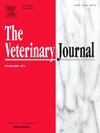香港宠物兽医使用抗微生物药物的情况。
IF 3.1
2区 农林科学
Q1 VETERINARY SCIENCES
引用次数: 0
摘要
香港一直就是否采纳国际准则,在伴侣动物护理中谨慎使用抗菌剂进行辩论。本研究旨在评估香港伴侣动物兽医的抗菌药物使用情况,并强调有针对性的干预领域。统计数据、抗菌药物处方行为和使用的抗生素类别通过在线问卷收集,调查对象是香港所有注册的伴侣动物兽医(估计为800-900)。在所有受邀兽医中,112人提交了调查问卷,74人完成了问卷。大多数应答者在初级保健机构工作(76.4%),为妇女(67.4%);85%的人报告说,他们的诊所没有正式的、书面的AMU政策。兽药手册是AMU使用的主要信息来源(76%),其次是课程或研讨会(64.6%)和临床医生的专业经验和判断(59.5%)。63%的患者极少出现有关AMU剂量和持续时间的依从性问题,21.5%的患者极少要求进行培养和抗菌药敏试验来指导使用AMU。大多数(71%)在60%至30%的病例中经验性地开具抗微生物药物。订购和开展药敏试验最常见的障碍是动物主人的经济负担(82%)、延迟开始治疗(56%)和时间限制(24%)。大多数答复者在清洁外科手术中从未或很少使用术前(81%)或术后(86%)抗菌药物。我们强调了抗菌素管理方面的主要差距,这些差距可以通过根据我们的发现为当地量身定制的指南、对兽医和宠物主人的教育以及改进抗菌素法规的执行来解决。本文章由计算机程序翻译,如有差异,请以英文原文为准。
Antimicrobial use practices among companion animal veterinarians in Hong Kong
Adopting international guidelines on the prudent use of antimicrobials in companion animal practices has been debated in Hong Kong. This study was conducted to assess antimicrobial use (AMU) practices among companion animal veterinarians in Hong Kong and highlight the areas for targeted interventions. Data on demographics, antimicrobial prescribing behaviors, and administered antibiotic classes were collected using an online questionnaire targeting all registered companion animal veterinarians in Hong Kong (estimated at 800–900). Of all invited veterinarians, 112 submitted the survey and 74 finished the questionnaire. Most respondents worked in primary care practices (76.4 %) and were women (67.4 %); 85 % reported the absence of a formal, written AMU policy in their clinics. Veterinary drug handbooks were the main source of information used for AMU (76 %), followed by courses or workshops (64.6 %) and clinicians’ professional experience and judgment (59.5 %). Owner compliance issues regarding the dosage and duration of AMU were never-rarely observed by 63 %, and 21.5 % reported they never-rarely requested culture and antimicrobial susceptibility testing to guide their AMU. The majority (71 %) prescribed antimicrobials empirically in > 30 % of cases. Most frequent barriers to ordering and conducting the susceptibility test were the financial burden on animal owners (82 %), delay in starting treatments (56 %), and time constraints (24 %). Most respondents never or rarely used preoperative (81 %) or postoperative (86 %) antimicrobials in clean surgical procedures. We highlighted key gaps in antimicrobial stewardship which can be addressed through locally tailored guidelines informed by our findings, education for veterinarians and pet owners, and improved enforcement of antimicrobial regulations.
求助全文
通过发布文献求助,成功后即可免费获取论文全文。
去求助
来源期刊

Veterinary journal
农林科学-兽医学
CiteScore
4.10
自引率
4.50%
发文量
79
审稿时长
40 days
期刊介绍:
The Veterinary Journal (established 1875) publishes worldwide contributions on all aspects of veterinary science and its related subjects. It provides regular book reviews and a short communications section. The journal regularly commissions topical reviews and commentaries on features of major importance. Research areas include infectious diseases, applied biochemistry, parasitology, endocrinology, microbiology, immunology, pathology, pharmacology, physiology, molecular biology, immunogenetics, surgery, ophthalmology, dermatology and oncology.
 求助内容:
求助内容: 应助结果提醒方式:
应助结果提醒方式:


